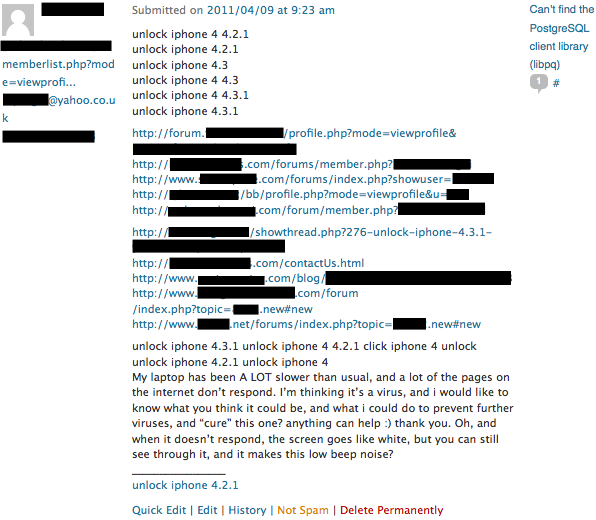As you may have noticed if you write a blog, however modest it might be (such as yours truly), you’ll receive spam comments. A lot. Things like that:
Spam like this is usually obvious. Thankfully, some spammers go out of their ways to create engaging messages to fool your filters, both automated (like Akismet, who dutifully collected all the ones exposed in this post) and human. I’ve been collecting the best of breed (I know, I live a very sheltered life), such as…
The Ones Sucking Up
Aaaah, the day-to-day of spam. “Magnificent”, nothing less!
“Famous”! Money! Girls! Bling! Bring it on!
“Amazing”, yay! Although I hope you realized you are trying to advertise train horns on a tech blog. Train horns.
The Confused Identities
Why thank you, Sabine â I mean Dave. Hmm, wait.
The Sarcastic
The colors on this post are amazing? Are you on drugs?
Ah, yes. Writing about SICP almost got me killed by M.I.T.’s own Secret Service. As a matter of fact, I’m hiding in Kazakhstan right now.
(On a serious note, I emailed Hal Abelson about a typo in the online version of SICP and received a very nice answer by him personally the very next day â hats off to you, sir!)
The Keyword Bingo
The Compliment That Wasn’t
This starts well… Grow, trendy, extremely amazing, attractive… Yeah, classical spam. But at closer look, this is actually a poorly translated troll insinuating that my post is unworthy. Darn!
The Cringe-Worthy
It is very telling whether you consider “incite full” or the concept of high-waist shorts to be the worst part of this spam. I can’t really pick, they’re both frightening.
The Big-In-Japan
A slight variation on plain sucking up is doing so in different languages.
Google translating that last one gives:
Hello interesting post, I liked a lot, maybe we could become blog palls:) lol!
Aside from the jokes call me Navid and look like you publish on the Internet although the theme of my room … this is very different.
I study the pages on poker free bonus without risking your cash … …
Greatly enjoyed what I saw written on this second visit
I shall return:)
Ps: I have a bad Portuguese
Thumbs up for the politeness and the disclaimer at the end. That’s top quality spam. Not so much to say for the reading skills though, because I don’t remember discussing online poker strategies together with ncurses.
The Philosopher
Wow! That turns out to be an (unsourced) citation of the late John Enoch Powell, a conservative English MP who’s also quoted as saying “reading one’s diary is like returning to one’s own vomit”, which may or may not be a more appropriate metaphor for blogs. And spam. Oh well.
The Prescient
Apart from the fact that they fscked up the URL bbtag â HOW DO THEY KNOW ABOUT MY SECRET PASSION!?
–
–
–
–
–
 pity the lolcat, by tizzie on flickr
pity the lolcat, by tizzie on flickr
What were your best ones?














